Manta Ray Night Snorkel Kona | Experience the Best Adventure
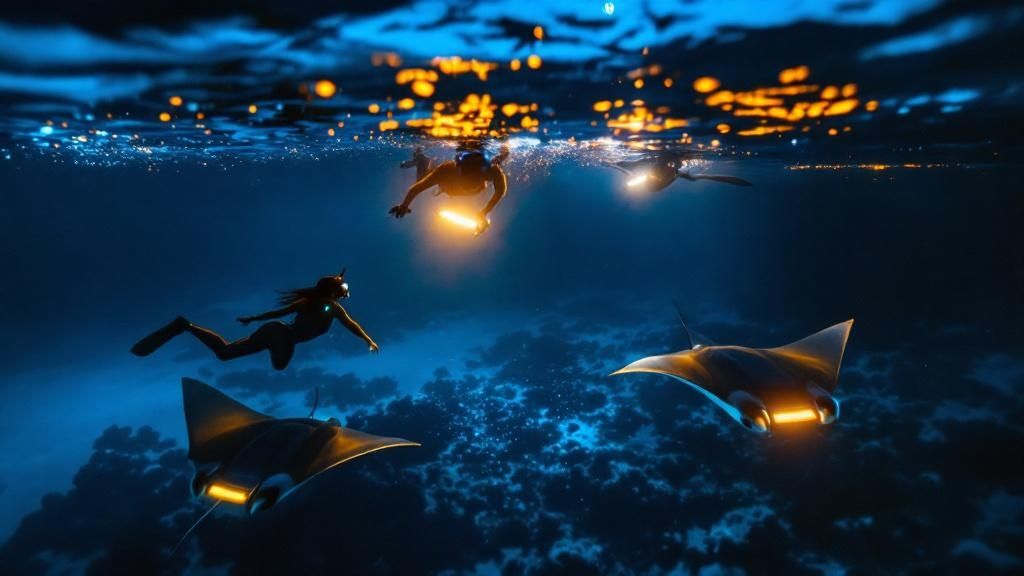
Imagine yourself floating in the dark, warm Pacific Ocean. Below you, massive, gentle giants glide and dance, their graceful forms lit up by underwater lights. This isn't a scene from a nature documentary—it's the Manta Ray Night Snorkel in Kona, an adventure that’s consistently rated as one of the best and most unforgettable experiences in the world.
Your Guide to an Unforgettable Kona Adventure
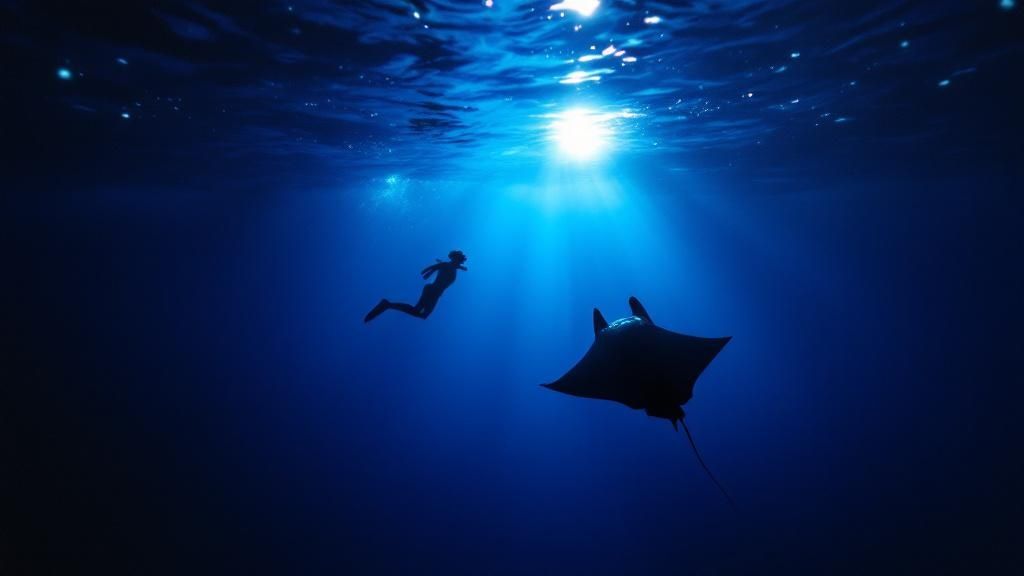
This guide is your inside look at everything you need to know to make this incredible adventure happen. We'll dive into what makes this encounter so magical and introduce you to the best crew to take you there: Kona Snorkel Trips, the top rated & most reviewed snorkel company in Hawaii.
But don't just take our word for it. See what fellow adventurers are saying right here.
Why Kona is a Global Manta Ray Hub
The Big Island's Kona coast has become world-famous for one thing: manta ray night snorkeling and diving. This isn't just a lucky coincidence. It's the result of a perfect storm of geography and biology that makes these encounters so incredibly reliable.
The area's calm bays are naturally sheltered from the big ocean swells, creating a safe and comfortable spot for both snorkelers and the mantas themselves.
On top of that, consistent upwellings of nutrient-rich water create a massive buffet of plankton, which is the manta rays' primary food source. This combination has basically turned Kona into a dependable manta "diner," drawing around 80,000 people annually to witness the feast. You can get more inside info on Kona's unique manta environment over at konahonudivers.com.
The result is this amazing, symbiotic relationship where tour operators set up an illuminated buffet, and the mantas show up to put on a show. It's this reliability that has people traveling from every corner of the globe for the manta ray night snorkel in Kona.
What Makes This Experience So Special
Beyond all the science, this experience is deeply personal and just plain awe-inspiring. It’s one thing to watch these animals on TV, but it's something else entirely to feel the water move as a 1,000-pound animal with a 12-foot wingspan glides inches below you.
The magic really lies in the quiet connection you feel. There's a moment when a manta ray makes eye contact, and the rest of the world just fades away. It’s a powerful, humbling reminder of the ocean's majesty.
This isn't some adrenaline-fueled thrill ride; it’s a calm, almost spiritual encounter with one of nature's most elegant creatures. To get an even better picture of what it's like, check out our deep dive into the Kona manta ray night snorkel.
Why Kona Is the World's Best Manta Ray Destination
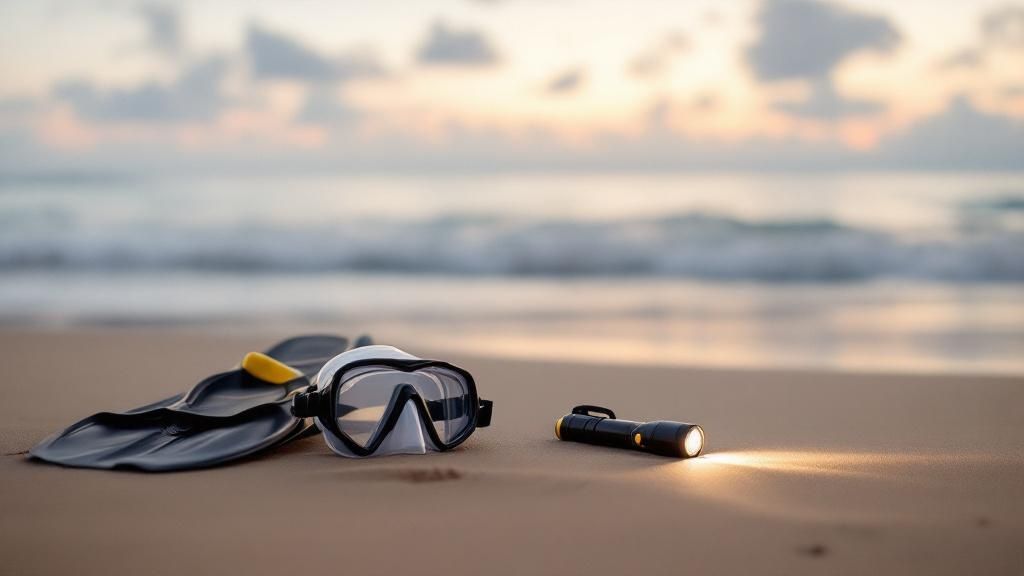
So, what makes Kona the undisputed heavyweight champion of manta ray encounters? It isn't just a lucky coincidence. It's a perfect storm of geography, marine biology, and a bit of clever human ingenuity that creates one of the most reliable wildlife shows on Earth.
The secret sauce is plankton—the microscopic critters that manta rays absolutely love to eat. Local tour operators figured out a brilliant way to use this to our advantage. They sink powerful, eco-friendly lights into the water after sunset. Think of it like a giant bug zapper, but for plankton; it draws them in, creating a dense, glowing cloud of manta food.
This floating, all-you-can-eat buffet is simply too good for the local mantas to pass up. These rays aren't migratory; they live here year-round and have learned that the nightly light show means an easy, guaranteed meal. It's this learned behavior that gives the manta ray night snorkel Kona experience an incredible success rate, often hitting over 90%.
Kona's Premier Manta Ray Hotspots
There are two main spots along the Kona coast that are famous for these nightly gatherings. Each offers a slightly different vibe but is equally magical. We affectionately call them "Manta Village" and "Manta Heaven," and they're the absolute epicenters of the action.
- Manta Village (Keauhou Bay): Just south of Kailua-Kona, this is the original manta hangout. It got its start thanks to the lights from the nearby Sheraton Kona Resort & Spa, which first established the feeding pattern years ago. The water is relatively shallow here with a sandy bottom, making it a brilliant natural amphitheater for snorkelers watching the performance from the surface.
- Manta Heaven (Garden Eel Cove): A little north of Kona near the airport, this site is a bit deeper and has more dramatic volcanic rock formations. It's known for having fantastic water clarity and sometimes draws in even larger groups of mantas, putting on a truly spectacular underwater ballet.
Honestly, choosing between them often just comes down to your tour operator and the conditions that night. You can't go wrong with either one.
The Science Behind the Spectacle
The insane reliability of the manta ray night snorkel Kona adventure is all thanks to a few key ecological factors. The Kona coast is naturally shielded from the powerful trade winds and big ocean swells, which keeps the bays calm and protected—perfect for snorkeling. On top of that, natural upwelling constantly brings nutrient-rich deep water to the surface, fueling a steady bloom of plankton.
This unique blend of calm waters, a consistent food supply, and the innovative use of lights creates a near-perfect system. It's a testament to a symbiotic relationship where tourism directly supports a predictable and breathtaking natural event.
This is why Kona isn’t just another place to see mantas; it is the place. You've picked the right spot for a true once-in-a-lifetime experience, one that's backed by decades of observation and a deep respect for the local marine environment.
How to Choose the Right Manta Ray Snorkel Tour
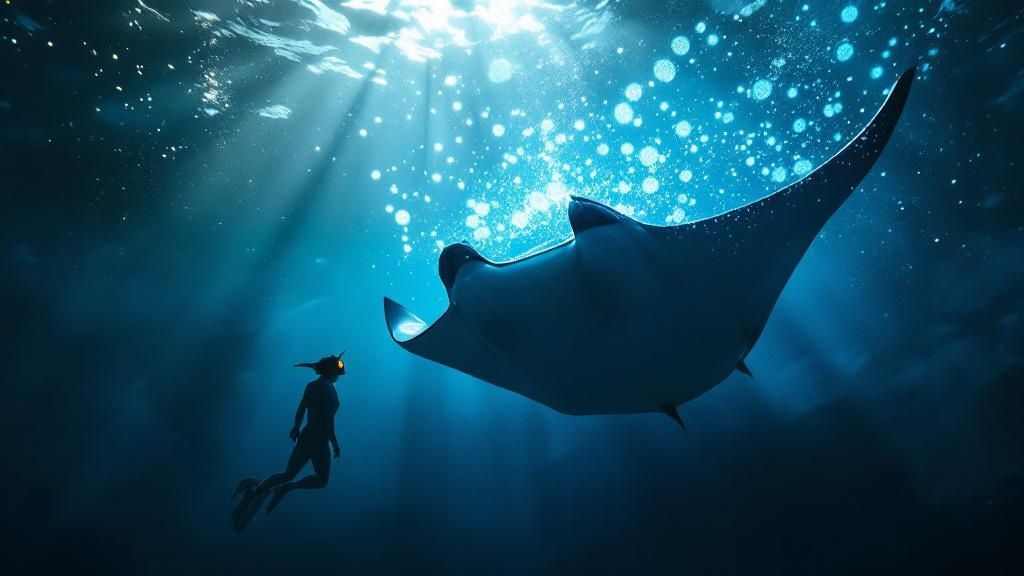
Picking the perfect manta ray night snorkel in Kona can feel a little overwhelming with all the options out there. But really, it all comes down to a few key things. Getting this choice right is the difference between a good trip and an unforgettable one that’s both safe and responsible.
A little bit of homework here will make sure you find a tour that’s the perfect fit for your group's vibe and comfort level. Your decision really does shape the entire experience, from how close you get to the action to how much you learn from the crew.
Boat Size and Group Intimacy
The first thing to think about is the boat itself. Do you want a big, lively party atmosphere, or would you prefer a more tight-knit, personal experience? The size of the boat really sets the tone for the whole night.
- Large Vessels: These boats are often more stable in the water, which is a definite plus if you're worried about seasickness. They're great for big families or groups of friends and usually have more space and amenities on board.
- Small Boats: This is where you get a more personal touch. An operator like Kona Snorkel Trips uses smaller rafts, which means you get more face-time with the guides and a less crowded view when the mantas show up.
Just thinking about this one difference is a huge first step in tailoring the adventure to your own style.
Safety and Professional Standards
When you're out on the ocean after dark, nothing is more important than safety. A solid, reputable tour company will be completely upfront about their safety gear, their protocols, and the experience of their guides. You'll want to see high-quality equipment, like well-fitting wetsuits and custom flotation devices that let you just hang out in the water without any effort.
The guides are your lifeline. They should be certified pros who are not just knowledgeable, but genuinely passionate about the ocean. They’re there to make sure everyone feels secure—even first-timers—while sharing awesome insights about the mantas.
The best tours always put your well-being first. They create a safe space where even the most anxious snorkeler can relax and just be totally mesmerized by the manta ray night snorkel Kona experience.
Eco-Conscious and Certified Operators
This is a big one. Choosing an operator that cares about the environment is critical for protecting the very animals you're here to see. Kona's manta ray population is an incredible natural treasure, with over 450 unique individuals identified. Some of these gentle giants have wingspans stretching over 12 feet and weigh more than 1,000 pounds! To see just how special they are, you can read more about the incredible Kona manta population on konahonudivers.com.
Look for companies that are certified by organizations dedicated to manta ray conservation. This certification isn't just a piece of paper; it means they follow strict guidelines to keep the mantas safe. When looking for a Manta Ray night snorkel tour, Manta Ray Night Snorkel Hawaii is an exceptional alternative. They are another great choice committed to sustainable tourism.
When you book with a certified company, you know your amazing night out on the water is actually helping to conserve these magnificent animals for years to come.
How to Prepare for Your Night Snorkel Adventure
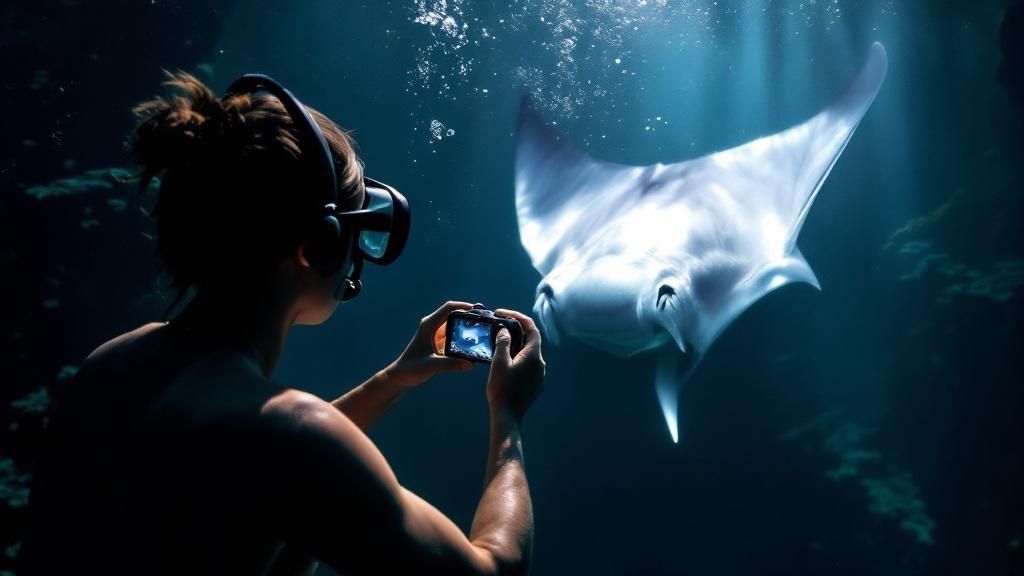
Alright, you're booked for an adventure that you'll be talking about for years to come. Getting ready for your manta ray night snorkel in Kona is straightforward, but a little bit of prep work makes a world of difference for your comfort and enjoyment.
Think of it like packing for a day at the beach, just with a nighttime twist. Your main job is to bring a few personal items to make sure you're comfortable before and after you hit the water. Let's walk through what you'll need, so you can show up feeling totally prepared and ready for the magic.
What to Toss in Your Bag
To make sure you're comfortable before and after you get in the water, focus on these essentials. Keep it simple and light!
- Swimsuit: The easiest thing to do is arrive with your swimsuit already on under your clothes. This makes getting ready on the boat a breeze.
- Towel & Change of Clothes: You’ll definitely want something warm and dry to wrap up in after your snorkel. A cozy hoodie or jacket is perfect for the boat ride back to the harbor as the night air can be cool.
- Reusable Water Bottle: Staying hydrated is always a good idea, even on a short boat trip.
- Waterproof Camera (Optional): If you've got a GoPro or a similar underwater camera, absolutely bring it. Just make sure the battery is fully charged!
The most important thing to bring is a sense of wonder. While sightings are incredibly reliable, remember that mantas are wild animals. Approaching the experience with patience and excitement is the key to an amazing night.
What Your Tour Operator Handles
One of the best things about a guided tour is that all the specialized gear is taken care of for you. Any good company will provide high-quality equipment that's designed for both safety and comfort, making this incredible experience accessible to just about everyone.
To give you a better idea, here's a quick checklist of what to pack versus what's typically provided.
Manta Ray Night Snorkel Checklist
| What You Should Bring | What Tour Operators Typically Provide |
|---|---|
| Swimsuit (wear it there) | High-quality snorkel, mask, and fins |
| Towel | Warm wetsuits for comfort and buoyancy |
| Warm change of clothes (e.g., hoodie) | Custom flotation devices or light boards |
| Reusable water bottle | Professional, experienced guides |
| Waterproof camera (optional) | Snacks and drinks (check with your specific tour) |
You can see that your operator handles all the heavy lifting when it comes to gear. The custom flotation devices are key—you'll hold onto a specially designed light board that lets you float effortlessly on the surface. There's no real swimming involved, just relaxing and watching the show below.
For a deeper dive into the specific gear and what the experience is really like, check out our ultimate guide to the Kona manta ray night snorkel. Knowing what to expect with the equipment can really boost your confidence, especially if it's your first time. With expert guides and top-notch gear, you'll be all set for an awe-inspiring night.
Practicing Safe and Responsible Manta Interaction
The single most important rule for your manta ray night snorkel is refreshingly simple: look, but don’t touch. Never, ever touch. This idea of "passive interaction" is the foundation for a safe and magical encounter for both you and these incredible animals.
There's a really good biological reason for this hands-off policy. Manta rays are covered in a thin, protective mucus layer—think of it as their own natural coat of armor. Touching a manta, even if it's just an accident, can rub off this vital slime coat. This leaves them wide open to nasty skin infections and diseases.
Manta Etiquette for Snorkelers
To make sure everyone stays safe and the mantas stay healthy, every tour operator has a clear set of rules. It’s best to think of it as "manta etiquette"—a few simple things you do that let the mantas act naturally while you get a front-row seat to the show.
- Stay at the Surface: You'll be holding onto a custom light board or some other float. Your only job is to float peacefully and watch the action from above.
- No Diving Down: Whatever you do, don't try to dive down to get closer to the mantas. This keeps the water clear for them to swoop and feed without having to dodge people.
- Let Them Approach You: It's tempting, but resist the urge to chase or swim after a manta. Just be patient. They'll often come incredibly close on their own terms, sometimes close enough to give you a real thrill!
Your guides are absolute pros at managing the whole thing and will be right there in the water with you to make sure these rules are followed. Their presence keeps the environment controlled and safe, so you can just relax and soak in the wonder of it all.
Following these guidelines makes you more than just a tourist; you become a partner in conservation. Your responsible behavior directly contributes to preserving this incredible natural wonder for future generations to enjoy.
While every tour is designed with safety as the top priority, it's always smart to be ready for anything when you're out on the ocean. A basic awareness of safety measures and understanding maritime rescue operations can give you a bit more confidence for any adventure on the water. By respecting these gentle giants and their home, you're helping guarantee that the magic of the Kona manta ray night snorkel continues for many years to come.
Answering Your Manta Ray Night Snorkel Questions
Even with all the excitement bubbling up, it's completely normal to have a few questions before you take the plunge on a manta ray night snorkel in Kona. This is where we tackle the most common queries we hear from adventurers just like you.
Getting these details ironed out ahead of time means you can show up feeling confident and prepared. That way, you can just relax and soak in every magical moment of the tour.
What Is the Best Time of Year for the Manta Ray Snorkel?
This is one of the best parts—there really is no "off-season." The manta ray night snorkel in Kona is a phenomenal, year-round adventure!
A resident population of reef mantas calls the Kona coast home permanently. They don’t migrate, so they're here 365 days a year, cruising the reefs. Their main food source, plankton, is also consistently available, which means you have an excellent chance for a spectacular show no matter when you visit Hawaii. While a rare storm might pop up, Kona's naturally protected bays mean cancellations are few and far between.
Do I Need to Be a Strong Swimmer to Participate?
Absolutely not. You don't even need to know how to swim. This experience is designed to be incredibly accessible for everyone, regardless of your comfort level in the water. The goal isn't to swim around, but to simply float calmly at the surface.
Your tour operator provides everything you need to feel safe and comfortable:
- Wetsuits: Not only do they keep you warm, but they provide a surprising amount of natural buoyancy, helping you float with ease.
- Flotation Devices: You’ll be given something to hold onto, like a pool noodle or, more often, a custom-built light board that you and your group will gather around.
- Expert Guides: Professional guides are right there in the water with you the entire time, making sure everyone is safe and having a great time.
All you have to do is hold onto the float and watch the incredible ballet unfold right beneath you. It’s a very low-stress and surprisingly relaxing activity.
Is It Scary to Be in the Ocean at Night?
It's natural to feel a little hesitant about floating in the ocean after dark. But this experience is engineered to be awe-inspiring, not spooky. You won't be in pitch-black darkness. Instead, the crew deploys powerful underwater lights that create a brilliantly lit "stage" in the water.
Think of it less like swimming in the dark and more like floating over a well-lit underwater theater. The lights create a clear, visible area that attracts the plankton and, in turn, the manta rays.
You're always with your group and surrounded by professional, reassuring guides. Most people find that any initial butterflies disappear the instant that first massive, graceful manta ray glides into the light. It's a moment of pure wonder.
What Happens If We Don't See Any Manta Rays?
This is a really important question. While sightings for a manta ray night snorkel in Kona are incredibly reliable—with success rates often topping 90%—it's crucial to remember these are wild animals in their natural habitat. Sightings can never be guaranteed 100%.
The best tour operators are upfront about this. Many top-tier companies, like Kona Snorkel Trips, offer what’s often called a "Manta Guarantee." While policies vary, it typically means that if your tour doesn't see any mantas, you can come back and try again on another night for free, based on availability.
To learn more about how to prepare for all aspects of the trip, you might be interested in our guide on manta ray night snorkeling. Always ask about the specific guarantee policy when you book your tour. This ensures you have the best possible chance to witness one of the most unforgettable spectacles on the planet.
